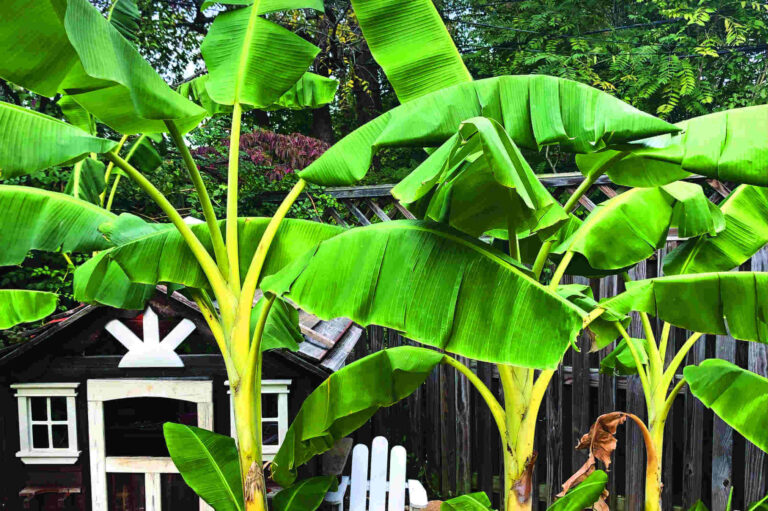One evening six years ago, a friend came to dinner at Brian and Schoen Oakes’ house and handed them a plant. But it was no ordinary cutting.
It was a plantain tree. It would never grow plantains, their friend told them. But it would thrive as long as they followed three simple instructions: plant it outside, cut it down before the first frost, and store it in a dry and dark place through the winter before replanting after the last frost in the spring.
So, Brian planted the tree in the yard of their home in Baltimore City’s Evergreen neighborhood, and the family watched it grow. The tree rose to 8 feet as its leaves spread, extending until they were enormous – some larger than a coffee table.
At the end of the season, just before the frost, Brian cut back the tree, dug it up, wrapped it in a trash bag, and stored it in their basement. In the spring, when he opened the bag, he was surprised to find a smaller plant next to the big one. He planted them together.
Over the years, the family’s plantain grove has grown. Every fall, Brian – who is one of my colleagues at Loyola University Maryland – transfers what the children call “the banana trees” to the basement. And, every spring, he and his wife, Schoen, pass along the new, smaller plants to family and friends – sharing the joy and responsibility that comes with the beautiful trees.
“We probably have 10 in our yard,” says Brian, who is associate vice president for advancement for Loyola and who, with his family, is a parishioner of the Cathedral of Mary Our Queen in Homeland. “We give away five to 10 a year to friends and family, and they send us photos of their own trees growing in their yards.”
The four young Oakes children love the trees. They pull off the massive leaves to play with them. The three girls fold them into purses. The Oakes’ preschool-aged son hides behind the leaves as if he’s in a fort. The children drape strings of beads over the branches. And each fall, Brian goes through the labor-intensive chore of storing the trees to prepare them for another growing season.
“It’s a huge chore,” Brian says, “but we sort of enjoy how much work it is. And we’re painfully aware of when the first frost is.”
Brian and Schoen were sure the trees would never bear fruit. Sometimes – just for fun – Brian would hang a banana on the tree for the children to discover when they came home from school.
“Then the kids caught on,” he said, laughing.
But last summer, for the first time, the family noticed something different – a bud on one of the trees. The bud produced small sausage-shaped sprouts that became a bunch of plantains.
“We were told it would never be hot enough for long enough to produce any fruit, so this was a complete surprise,” said Brian. “We fried them up and ate them. They were delicious.”
Isn’t it beautiful that a simple offering made in thanks for hospitality has grown into a group of trees that have been planted in yards of family and friends – and that one has even sprouted fruit?
During this season of giving, as we thoughtfully select gifts for people we know and love – and maybe even for strangers – how wonderful to consider that a gift may bring joy not just in the moment of opening, but also for years to come. The beauty of a gift, or any kind gesture, is that it can produce surprising and wonderful fruit far beyond the initial moment when it is opened.
This Advent season may we find beautiful ways to give and to accept the gifts of others. And, as we prepare to receive the most wonderful gift of all, Jesus, born in a stable on Christmas Day, may we see that embracing that gift from Our Father in Heaven is one that can yield wonderful fruit not just in our lives but in others’.
“God is always trying to give good things to us, but our hands are too full to receive them,” St. Augustine said.
May we approach this Christmas with our hands, minds and hearts full and ready to accept the love and joy of the season.
For more on Advent in the Archdiocese of Baltimore, click here.



